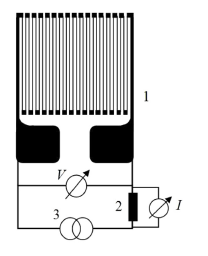Transient Hot Point Method
What is the THP Method (Transient Hot Point Method)?
A Hot Point Sensor is a small Transient Plane sensor with a dimension of 3×3 mm which can be attached to a Transient Hot Bridge instrument. It is designed to measure the thermal conductivity of small samples (e.g. single coffee beans, peanut beans etc.) and to measure anisotropic materials.
In recent years, continued miniaturization of electronic devices has also led to small size (micro) resistance temperature detectors (mRTDs). These are particularly suited for flexible measurements of surface temperatures. Now, such a mRTD is used as a thermal transport properties sensor since it also enables a predefined local heating of a surrounding medium to be analysed. In conjunction with an appropriate working equation, a suitable mRTD-type can, thus, open a new window of potential “small volume scale” applications.
 Hot Point Sensor
Hot Point Sensor
Scientific Publication:
The Transient Hot-Point Sensor (THP) technique, the underlying mathematical model and measurement examples are presented in this publication: Thermophysical properties of a single coffee bean, a single peanut and an IC-Package
